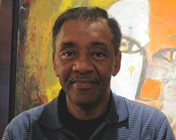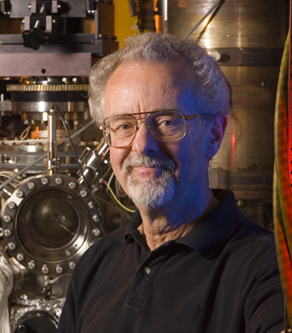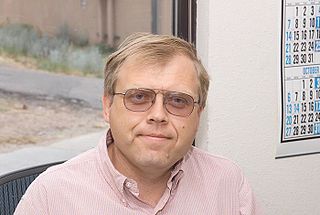Career
Slaughter's career includes more than twenty-two years of administrative service, refereed articles in top-rated journals, refereed proceedings, seven book chapters, and more than fifty invited national and international presentations.
These activities were of a multi-disciplinary nature involving research in nuclear physics, particle physics, medium-energy physics, detonation theory and applications, computational physics, and education with a special emphasis on issues involving underrepresented minorities, women, and the disadvantaged.
Slaughter's career in research, teaching, administrative, and service interests have been wide-ranging and include theoretical and phenomenological nuclear and particle physics, intense field quantum optics, shock wave physics, nanotechnology, computational science, biophysics, and their applications to "real-world" problems of interest and extend to developing innovative and effective programs in STEM.
Helping to develop STEM–associated disciplines (where societal considerations are often paramount) have always been important to him.
Slaughter has also presented international talks on how one may perhaps understand from a quantum point of view the interaction of ultra-high intensity laser pulses with biological and environmental physical systems at the nanoscale.
He has also served as a consultant, session chair, moderator, workshop and conference organizer, course lecturer, and panelist for many national and international activities in addition to being the recipient of numerous awards from the National Science Foundation and the Louisiana Board of Regents.
Los Alamos National Laboratory
At Los Alamos National Laboratory, Slaughter held the positions of staff physicist in detonation theory (1977–1981), affirmative action representative for the LANL Theoretical Division (1978–1984), staff physicist in the LANL Nuclear and Particle Physics Group of the Medium Energy Physics Division (1987–1989), and was a member of the Advanced Hadron Facility Beam Energy Group and the Applications Group of the Theoretical Division. He was the first African-American assistant theoretical division leader for administration (1981–1987), and laboratory-wide project manager for the LANL, Historically Black Colleges and Universities project manager (1983–1986). [1] He was nominated for the LANL Distinguished Performance Award. [5]
Representing Los Alamos National Laboratory as HBCU project manager and reporting to LANL's associate director for physics and mathematics (Warren F. Miller, Jr.), and under the auspices of Presidential Executive Order 12320, Slaughter negotiated with Department of Energy (DOE) Forrestal Headquarters, DOE Germantown, DOE Albuquerque Field Office, and DOE Los Alamos Area Office personnel for funding of HBCU programmatic activities, created the Laboratory administrative and managerial infrastructure necessary to support a program whose focus was external aid to HBCUs and whose funding was provided directly from DOE and organized the first national laboratory conference that brought representatives of over 30 HBCU schools to Los Alamos to confer with Laboratory scientific personnel on research initiatives in all areas of physics, chemistry, and mathematics.
Slaughter's conference led to direct DOE funding via subcontract for equipment and personnel at several HBCUs (Alabama A&M University, Howard University, and Southern University, Baton Rouge), the establishment of a summer internship program for HBCU students first conducted at Los Alamos in 1985, and the inception of several very fruitful collaborations between Los Alamos National Laboratory scientists and HBCU professors.
University of New Orleans
In 1989, Slaughter was appointed professor (with tenure), chair and department head (1989-1999) of the Department of Physics of the University of New Orleans, [1] (formerly known as Louisiana State University in New Orleans).
He served as chair and member of the American Physical Society Committee on Minorities in Physics (1989–1991) [5] and was elected general member-at-large and executive committee member and Officer of the American Physical Society Forum on Education (1995–1996 term). [6] [7]
Slaughter received a number of Louisiana Education Quality Support Fund (LEQSF) grants:
(1) Enhancement of the Research Capabilities of the University of New Orleans Department of Physics, $150,000, Contract Number LEQSF (1990–91) -ENH-56, June 1990. With Co-Principal Investigator Dr. Ronald Greene of the University of New Orleans;
(2) Co-Principal Investigator and Participant, Integrating Computers into the Core Physics Curriculum, Louisiana Education Quality Support Fund, With Principal Investigator Dr. Ronald Greene. $67,121, 1 July 1993 - 30 June 1994;
(3) Graduate Fellowships in Physics at UNO. August 94 - July 96. LEQSF 8g. Funded @ $26,400;
(4) Graduate Fellowships in Physics at UNO. August 95 - July 97. LEQSF 8g. Funded @ $28,800;
(5) Graduate Fellowships in Physics at UNO. August 96 - July 98. LEQSF 8g. Funded @ $28,000;
(6) Graduate Fellowships in Physics at UNO. August 97 - July 99. LEQSF 8g. Funded @ $62,400;
(7) Graduate Fellowships in Physics at UNO. August 98 - July 2000. LEQSF 8g. Funded @ $24,000.
He also as Co-Principal Investigator received a Louisiana Board of Regents Support Fund grant entitled Enhancement of the Applied Optics Laboratory for Instruction and Research—A Plan to Positively Improve Minority Science Education., $117,946. June 1, 2002 – May 31, 2003. With Principal Investigator Dr. Ashok Puri of the University of New Orleans.
Slaughter was a recipient of a National Science Foundation five year continuing grant entitled: Research on an Algebraic, Nonperturbative Approach to Hadrons and Glueballs, Award Number: 9012374; NSF Organization: PHY, Start Date:02/01/1991; Award Amount:$224,000.00. [8]
Slaughter was co-principal investigator of the National Science Foundation grant entitled A Workshop for the American Physical Society's Corporate Sponsored Scholarships for Minority Undergraduate Students Who Major in Physics, $30,000, grant number HRD-92 53144, Summer of 1992. With Co-Principal Investigators, Dr. Anthony M. Johnson then Distinguished Professor of Physics and chair, New Jersey Institute of Technology and Dr. Brian Schwartz, then American Physical Society Associate Executive Secretary and Professor of Physics, Brooklyn College. sponsored by the National Science Foundation and hosted by Hampton University and conducted at the Thomas Jefferson National Accelerator Facility. [9]
He was appointed as a Charter Fellow of the National Society of Black Physicists in 1991, [1] and elected as a Fellow of the American Physical Society in 1999 with the citation "For creating effective programs that attract and educate minority and female physics students and involve historically black colleges and universities in forefront research". [5] [10]
In conjunction with a colleague at Xavier University of Louisiana, Slaughter obtained a cooperative agreement [11] in 1992 (1992–1999) from the National Science Foundation (NSF) which established a nationally unique Research Careers for Minority Scholars (RCMS) Graduate Dual Degree Program which aided minority senior undergraduates at Xavier in receiving dual degrees (B.S. from Xavier and M.S. from UNO) in computer science, engineering, mathematics, and physics. [11] The RCMS program was a highly regarded and very successful program designed to increase the probability that beginning undergraduate science, mathematics, or engineering minority students would successfully obtain graduate degrees and was the forerunner of the Louis Stokes Alliance for Minority Participation (LSAMP) program in Louisiana for which Slaughter was a Phase One co-principal investigator and associate director. [12]
Slaughter was the initiating developer of the State-wide [all 12 major public and private Louisiana Universities and Colleges] Louis Stokes Alliance for Minority Participation (LSAMP) program in Louisiana and brought in three Co-Principal Investigators and became its associate director, Phase One, November 1, 1995 - December 31, 2000. Five year state-wide continuing Cooperative Agreement (NSF No. HRD-9550765) was funded at $5,000,000 (NSF) and $2,500,000 of matching funds from the Louisiana Board of Regents. In addition, at UNO, Slaughter also designed and directed the "Next Step" LSAMP program component designed to increase the probability that underrepresented minority students who majored in STEM fields ultimately succeed in obtaining the Bachelor of Science degree. The "Next Step" Program produced more than 100 graduates. [13]
Slaughter also completed: (NSF Proposal 0429721) for Dr. Ashok Puri in support of a Presidential Award for Excellence in Science, Mathematics, and Engineering Mentoring (PAESMEM) resulting in NSF Grant Number: HRD 0528179, received by Dr. Ashok Puri (PI) (2005-2007).
Florida International University
In 2006, after Hurricane Katrina devastated New Orleans, Slaughter became professor emeritus and department head and chair emeritus of the University of New Orleans and visiting (affiliate research) professor of physics of the Florida International University in Miami, Florida. [1]
Slaughter is currently affiliate professor of physics, Department of Physics, Florida International University.
A recent short article, "Reflections in Diversity: Increasing Minority Participation in University STEM Programs" by Slaughter for the Optical Society of America [14] demonstrates his immense enjoyment working with federal, state, and local agencies, international agencies, corporations, and foundations to increase the number of female and underrepresented minorities in science, technology, engineering, and mathematics.
In April 2019, Slaughter developed a much longer, detailed ″White Paper″ entitled "Status of Underrepresented Minorities in Science, Technology, Engineering, and Mathematics (STEM)", which included a program solution outline for a university organizational unit (UOU). [15]
Slaughter is currently chair of the Edward Bouchet Abdus Salam Institute (EBASI) of the Abdus Salam International Centre for Theoretical Physics (ICTP) located in Trieste, Italy, initiated the creation of a memorandum of understanding between ICTP and EBASI, [3] and garnered workshop funds from NSF to support EBASI scientific and technological activities in South Africa.
He was a member of the International Organizing Committee, US-Africa Workshop on Nanosciences [16] and received an invitation as an international expert by the International Atomic Energy Agency (IAEA) [17] [18] to serve on a nuclear science education and accelerator training enhancement panel.
In 2014, he was elected to the rank of Fellow of the American Association for the Advancement of Science (AAAS) and honored for "contributions to non-perturbative elementary particle and nuclear physics and for the creation of effective educational programs involving minority and female STEM students". [5] [19]
In December, 2014, Slaughter was named a STEM Founding Fellow of the STEM Transformation Institute at Florida International University. [5] [20] ·
August, 2020, Niels Bohr Library & Archives, American Institute of Physics, College Park, MD USA, Interview of Milton Slaughter, https://www.aip.org/history-programs/niels-bohr-library/oral-histories







